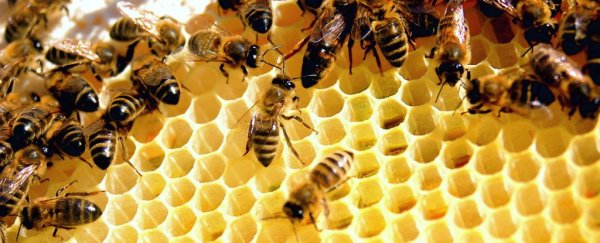Honeybees have long been known to communicate using a "whooping" noise that's inaudible to human ears.
While scientists have assumed that these communications were used as 'stop signals' for other bees trying to forage, new research shows that, adorably, the noise might just be conveying surprise.
"We have found that this signal is remarkably common, much more than previously thought," said one of the team, physicist Martin Bencsik from Nottingham Trent University in the UK.
It's well known that honeybees communicate through vibrational signals, but why the bees actually make them has been up for debate.
Back in the 1950s, scientists suggested that the vibration signal was used as a request for food, as they observed that the noise was often followed by the bees exchanging meals.
Later, researchers also noticed that the noise was used to inhibit another bee from performing a waggle dance – a form of communication used to tell other bees where to go to forage.
The stopping of this waggle dance suggest that it worked as a 'stop signal'.
But new research suggests that the way the bees were investigated in those past studies was flawed, and the signal is more common than we thought.
"Scientists in the past have explored this signal in artificial circumstances where they ensured that the bees under investigation would be trying to inhibit other bees," said Bencsik.
In the latest research, the team placed accelerometers into the centre of two hives in the UK and France to record bee noises that are inaudible to the human ear.
The vibrations were recorded for a year, and computer software scanned the recordings for the vibration "whooping" noise.
"In our study, we have not manipulated our bees in any way, and this has revealed totally unexpected results, yielding new interpretations but also yet more mystery around this brief honeybee vibrational pulse," said Bencsik.
"We believe that in only a small number of instances is it used as an inhibitory signal and therefore have proposed a new name – the 'whooping' signal."
They found that the accelerometer would pick up six or seven whoops a minute, and from a very small area in the honeycomb.
"There's no way a bee was trying to inhibit another one that frequently, and there's no way a bee would request food that frequently," Bencsik told Sam Wong at New Scientist.
When the researchers also placed cameras inside the hive, they noticed that it happened most when the bees bumped into each other, but it also happened if the hive was shaken.
"We suggest that, in the majority of instances, it is bees being startled that produce the signal," says Bencsik.
In other words the bees are doing the bee equivalent of a surprised gasp – and it makes these adorable noises even better:
But the researchers aren't done yet – the team is now investigating if stressed colonies whoop more than unstressed colonies.
"It shows promise that our methods can be used as a sensitive way of monitoring and assessing colony status for these hugely important pollinators," said one of the researchers, Michael Ramsey.
Considering researchers are looking at Black Mirror-style bee drones to replace the real thing, we'll take anything to help the current population.
Plus we don't want to lose those cute "whoops".
The research has been published in PLoS ONE.
